The Chapel was built in 1900, commissioned by Willem Carel Philip Otto, Count of Aldenburg Bentinck and Waldeck-Limpurg, owner of the Weldam and Middachten Estates. As from April 1894 the Evangelisation Society in Goor held its services in the woodshed located behind the chapel. Count Bentinck found this not to be a suitable place for the preaching of the Gospel and therefore he commissioned the building of the chapel with a seating capacity for 150 people end 1898 or early 1899.
The Chapel was designed by William Samuel Weatherley, son of Samuel Weatherley and Mary Anne Tuxford, born 1850 in Hatcham, Surrey, England. In 1880, at the beginning of his career, he became an assistant to the famous architect Sir George Gilbert Scott, located in 20, Cockspur Street, London, who was celebrated as a draughtsman and was widely involved in church restorations. The chapel was largely built by employees of the Weldam Estate. As from April 1894 the Evangelisation Society in Goor held its services in the woodshed located behind the chapel. Count Bentinck found this not to be a suitable place for the preaching of the Gospel and therefore he commissioned the building of the chapel in 1900 with a seating capacity for 150 people. In 1896 Count Bentinck had already had a chapel built in the Markelo community of Stokkum (this was demolished in 1955). The chapel at Weldam was consecrated on June 3rd 1900 by Ds. Barbas from Haarlem. The first evangelist was G. Vogel, who on retirement was followed by G. Wortman who held his farewell service on January 31st 1949 as a result of the decision of the Weldam Estate to close the chapel. The reasons for closing the chapel were the declining interest and because the costs associated with the evangelisation were becoming difficult to raise. From 1950 the chapel was used in the summer months by the Dutch Reformed Church in Goor for holding services. At the time the church was used for weddings. As from December 1979 the chapel has been used by the Anglican Church Twente for holding services in the English language until 1996 on the first, third and fifth Sundays in the month. As from 1996 services have been held every Sunday.
 William Samuel Weatherley was involved in the design and restoration of several parish churches in England. Of some of these documentation could be found
William Samuel Weatherley was involved in the design and restoration of several parish churches in England. Of some of these documentation could be found Leake, East, St. Mary the Virgin (1885-1887), Nottinghamshire, The first chapel of which documentation could be found of that he was involved in. He had to design a new seating plan and make a plan for repairs. This was approved by the church council.
Brandesburton, St. Mary (1889-1890) Yorkshire, this existing church had to be modified with a new vestry and organ chamber, reseating and general repairs. His proposals, however, were rejected.
Loughborough, St. Peter (1909-1913) Leicestershire, here Weatherley was part of a consortium of three Architects. This design was approved by the church council
Norbury, St. Stephen (1907-1913) Surrey, With this church design Weatherley was on his own,
Normanton-upon-Soar, St. James (1889-1890) Nottinghamshire,
Streatham, St. James, West Streatham (1913-1915) Surrey After Sir George Gilbert Scott architects bureau had received the order for drawing a plan for the Chapel at the Weldam Estate early 1899, William Samuel Weatherley was tasked with the design and he did finalize most of the initial drawings of the planned Chapel on March 29th 1899. Around 1910 he started his own architectural design bureau and took office in 4 Suffolk Street, Pall Mall London. He did specialize as an English Gothic Revival architect, in the English building style of the turn of the Century; the cottage style. The building of the Chapel was largely performed by employees of the Weldam Estate. After a building process of just over a year, the Chapel was consecrated on June 3rd 1900 by Ds. Barbas from Haarlem. William Samuel Weatherley passed away in 1922.
Chapel original drawings by William Samuel Weatherley (1899) - Courtesy Count Alfred zu Solms-Sonnenwalde
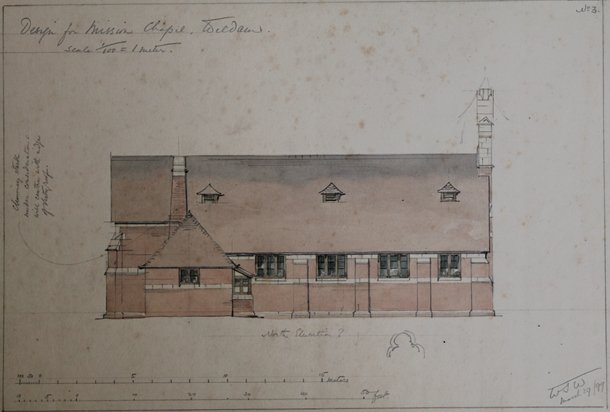 Chapel side view drawing (facing South)
Chapel side view drawing (facing South) North east and South west views.
North east and South west views.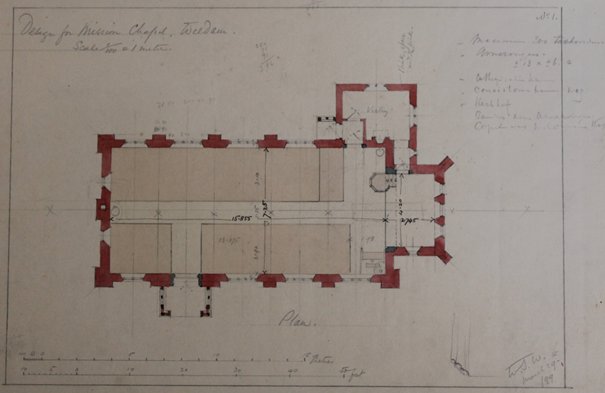 Original chapel plan view drawing with Dutch language handwritten
Original chapel plan view drawing with Dutch language handwritten  Original chapel plan view drawing with Dutch language handwritten construction details
Original chapel plan view drawing with Dutch language handwritten construction details  Orientation of the Chapel
Orientation of the Chapel Chapel South face
Chapel South faceFoundation works and wall construction.
 The foundations of the chapel have been laid out quite heavily. To support the buttresses, first approximately 360 centimetres long wooden piles (probable oak) have been driven into the ground, on top and integrating these wooden piles a concrete block with a thickness of 60 centimetres has been poured. On top of the concrete the first layer of bricks has been positioned. The outside walls are supported by several buttresses set at regular intervals in between the windows. (See image plan view with construction details). At the South west face three buttresses support the wall. One of these buttresses also supports a combined chimney and the belfry. At the northern side two buttresses have been fitted on both corners because of the three windows and narrower measurements. All buttresses have been constructed with a broader lower (30cm) section and a narrower (20cm) top section.
The foundations of the chapel have been laid out quite heavily. To support the buttresses, first approximately 360 centimetres long wooden piles (probable oak) have been driven into the ground, on top and integrating these wooden piles a concrete block with a thickness of 60 centimetres has been poured. On top of the concrete the first layer of bricks has been positioned. The outside walls are supported by several buttresses set at regular intervals in between the windows. (See image plan view with construction details). At the South west face three buttresses support the wall. One of these buttresses also supports a combined chimney and the belfry. At the northern side two buttresses have been fitted on both corners because of the three windows and narrower measurements. All buttresses have been constructed with a broader lower (30cm) section and a narrower (20cm) top section. 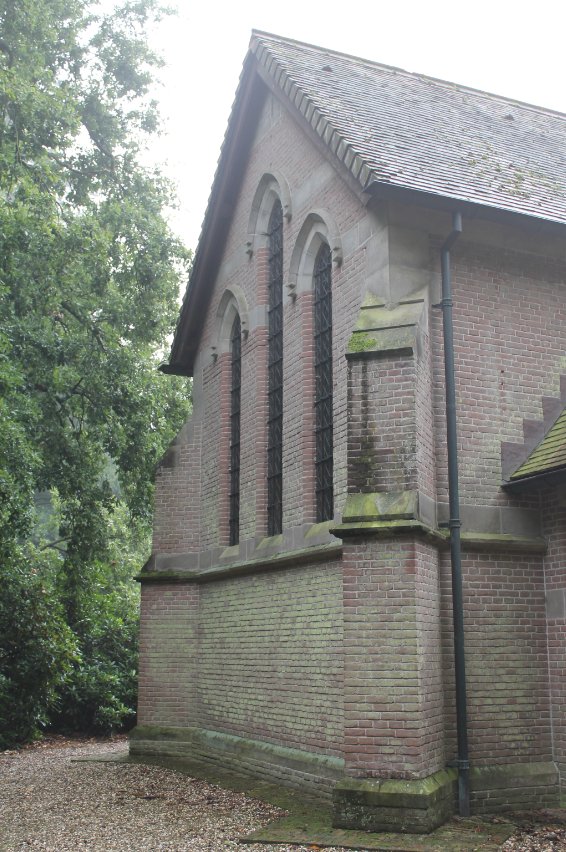
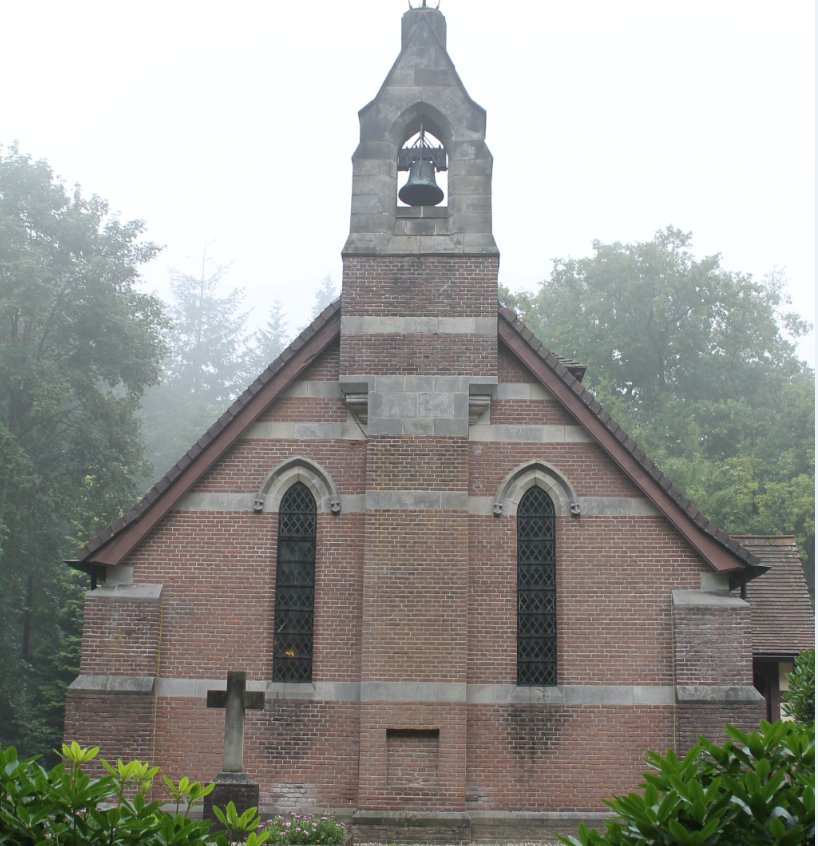 The walls do have a less strong foundation, the three bottom layers were set up of five stones in width, then two layers 4½ stones in width, on top of these two layers of 3¾ width. Seven layers of 3½ width bricks complete the foundation to the watermark. On top of the watermark level three more bricks are placed supporting a sandstone block which indicates the lowest mark of the wall construction.
The walls do have a less strong foundation, the three bottom layers were set up of five stones in width, then two layers 4½ stones in width, on top of these two layers of 3¾ width. Seven layers of 3½ width bricks complete the foundation to the watermark. On top of the watermark level three more bricks are placed supporting a sandstone block which indicates the lowest mark of the wall construction.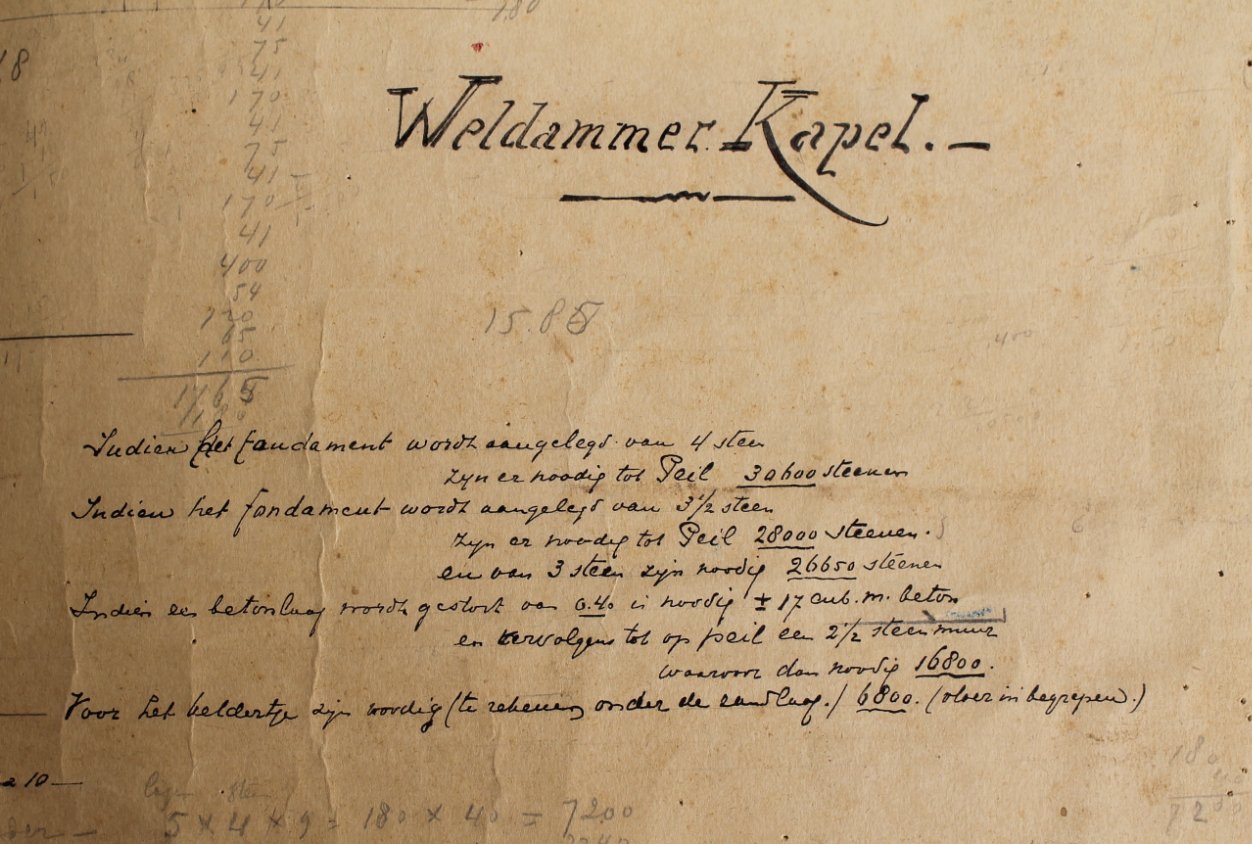
The architect probably made a rough calculation on the number of bricks to be used for the chapels foundation works as may be seen from the above image.
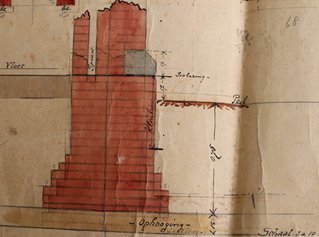
 The wall depicted on the left image is either the North east or South west wall of the chapel. These are both constructed of a two brick outer wall section, a cavity and half brick inner wall section.
The wall depicted on the left image is either the North east or South west wall of the chapel. These are both constructed of a two brick outer wall section, a cavity and half brick inner wall section.The side walls of the Chapel have been constructed of 1½ bricks, a cavity and ½ brick as the inner wall. The northern and southern walls are slightly stronger with 2 bricks, cavity and ½ brick strength inner wall side. The vestry is built up of 1 brick, a cavity and then ½ brick as inner wall. The brick wall has been plastered on the inside of the building to create a smooth surface. The sand stone blocks have not been plastered to retain their specific appearance. On the outside of the building dark red bricks have been used for the complete building, except for sections around the main entrance and the windows which are lined with sand stone blocks.

At the north eastern side of the Chapel next to the pulpit, separating the liturgical centre from the nave, the integrity of the construction is supported by a plastered 1½ strong brick wall extending each side from the side walls, culminating into a pointed arch which is typical to Gothic construction techniques. This arch is additionally reinforced with another pointed arch supported by a supporting structure either side. This pointed arch wall is also part of the exterior wall. The width of this liturgical centre is also more narrow then the nave, as is the roof.

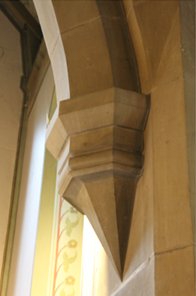 Drawing of pointed arch at top of nave (image left) Supporting structure (image right)
Drawing of pointed arch at top of nave (image left) Supporting structure (image right)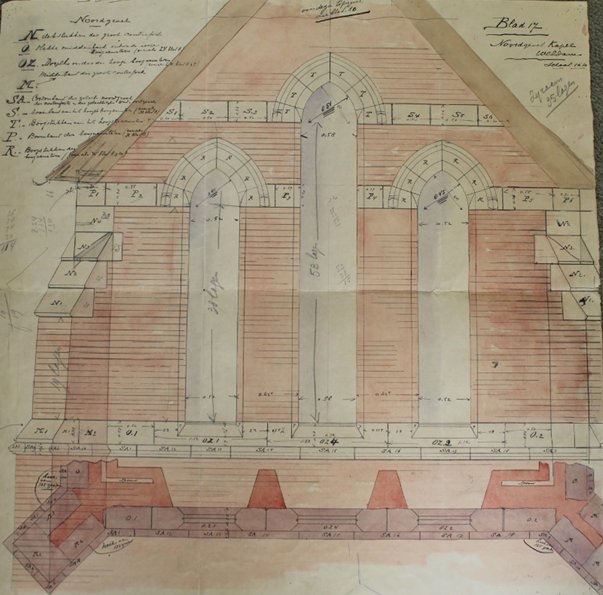 North east face – showing details on buttresses, inset of sandstone blocks and the arrangement of the windows.
North east face – showing details on buttresses, inset of sandstone blocks and the arrangement of the windows.At the North eastern side the extension for the vestry had been connected to the main building. One may note that the vestry annex is overlapping the wide and narrow sections of the chapel on this side of the building. Both buttresses on the North east face have been angled out to 45 degrees to support this section. Because of the three windows only two buttresses could be constructed on this side. These buttresses also appear to be of a stronger construction then the others used on the three remaining sides.
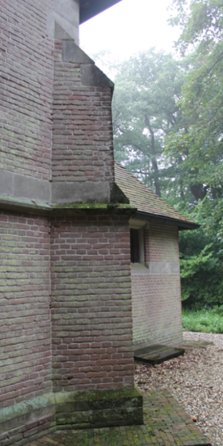
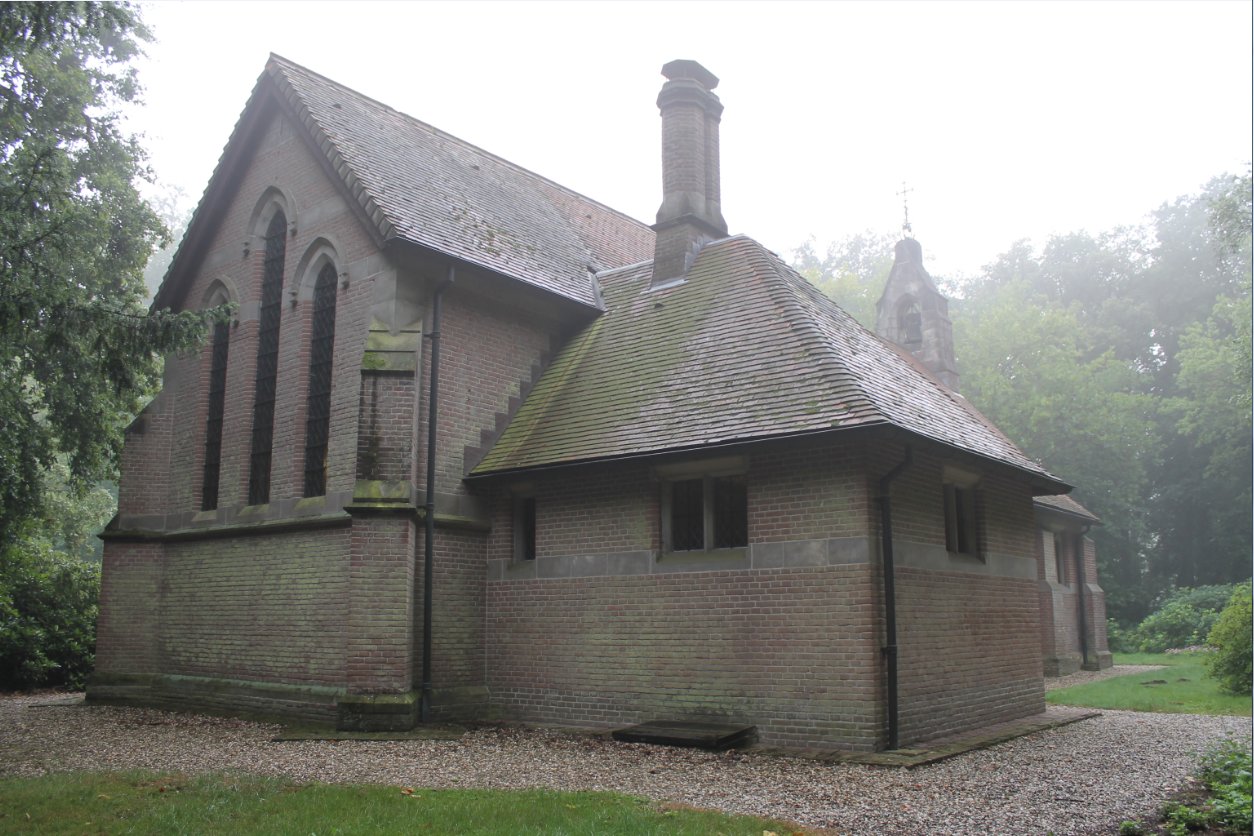
At the North eastern side the extension for the vestry had been connected to the main building. One may note that the vestry annex is overlapping the wide and narrow sections of the chapel on this side of the building. Both buttresses on the North east face have been angled out to 45 degrees to support this section. Because of the three windows only two buttresses could be constructed on this side. These buttresses also appear to be of a stronger construction then the others used on the three remaining sides.
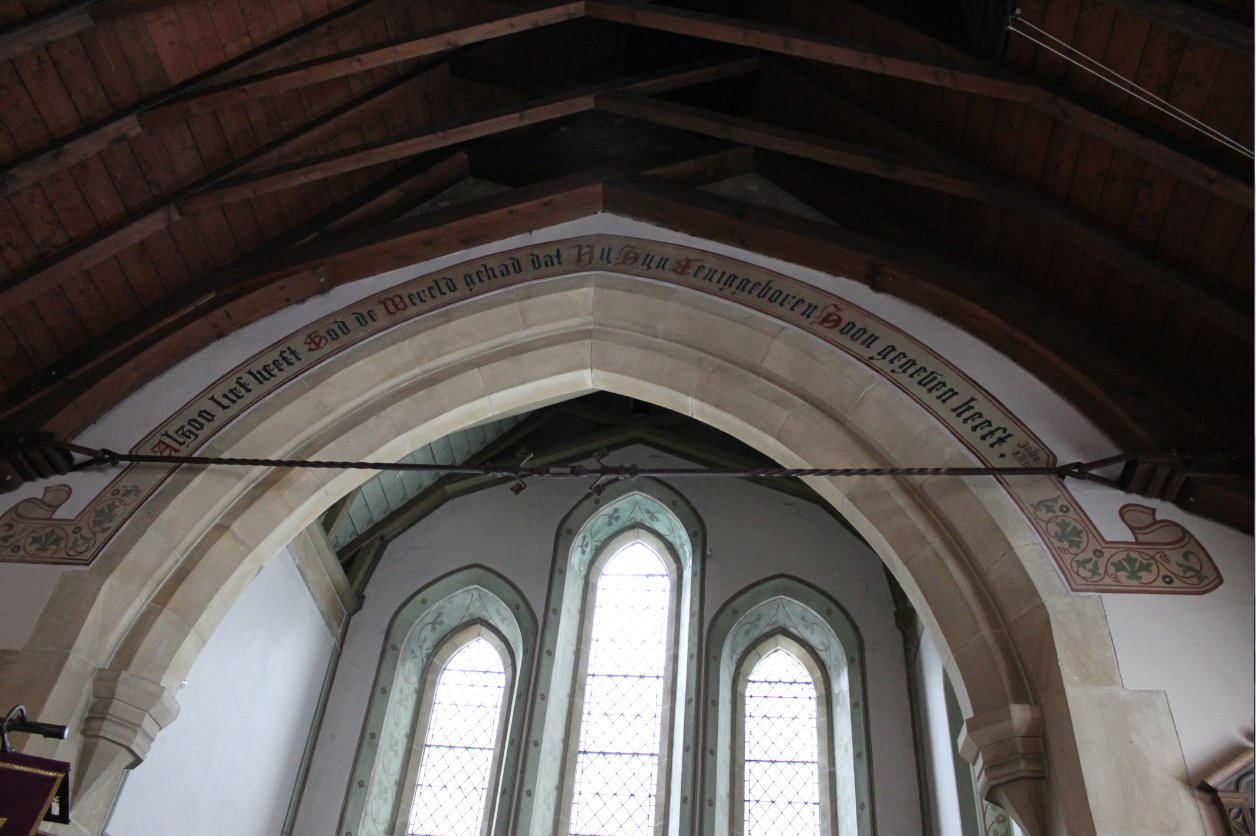
On the inside of the chapel the walls have been plastered white. Also liners of sand stone have been used to indicate wall ends or set around windows and doors.
Wood panelling.
The complete lower wall section has been cladded with wood ornamented panelling. Each panel is fitted at the top section with a curved ornament, reappearing in the adjacent panels. On top of all panels rounded square blocks separated by a gap, strips are mounted.
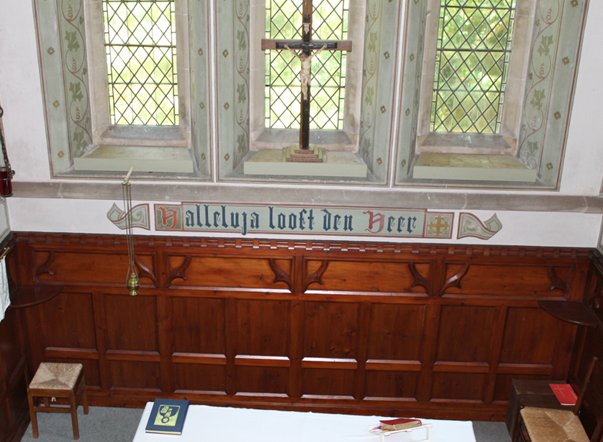
North eastern face panelling
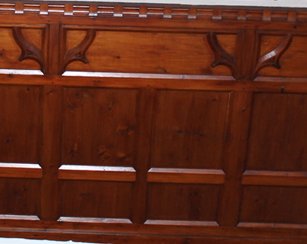
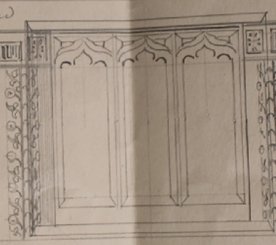
Ornamented Panel (image left) Drawing for panel (image right)
Access to Chapel – Main Entrance
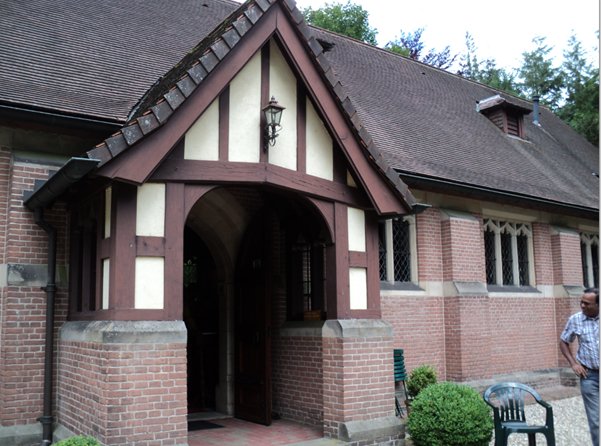 The gable roofed porch is partly constructed of a brick wall with a timber-framed section on top. The timber frame is filled-in with plaster sections.
The gable roofed porch is partly constructed of a brick wall with a timber-framed section on top. The timber frame is filled-in with plaster sections. 
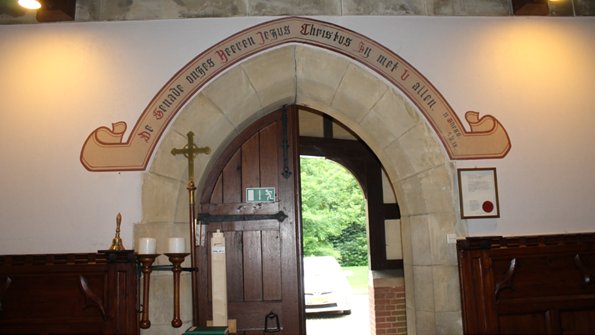 The main entrance to the Chapel is situated on the South east face. The door is sheltered by a gable roofed porch. The roof of the porch is supported by a scissor truss construction. The actual entry of the Chapel is again constructed of a sandstone portal culminating in a pointed arch. The construction of the wall is partly in exposed bricks and partly plastered. In either side of the porch a double set of glassless mock windows have been fitted. The construction is similar to the side windows of the Chapel, however without any glass fitted. The Main Entry Porch double opening doors are set in a pointed stone arch. The heavy double opening wooden pointed arch doors are hinged on the outside with ornamental wrought iron hinges. On the inside single wrought iron straight hinge reinforcement has been fitted as well.
The main entrance to the Chapel is situated on the South east face. The door is sheltered by a gable roofed porch. The roof of the porch is supported by a scissor truss construction. The actual entry of the Chapel is again constructed of a sandstone portal culminating in a pointed arch. The construction of the wall is partly in exposed bricks and partly plastered. In either side of the porch a double set of glassless mock windows have been fitted. The construction is similar to the side windows of the Chapel, however without any glass fitted. The Main Entry Porch double opening doors are set in a pointed stone arch. The heavy double opening wooden pointed arch doors are hinged on the outside with ornamental wrought iron hinges. On the inside single wrought iron straight hinge reinforcement has been fitted as well. Entrance through the Vestry
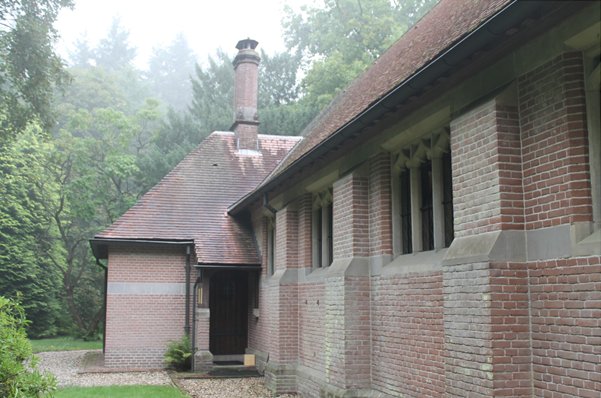
The entrance to the vestry is set in a small porch which has a roof extending from the vestry. The rectangular wooden panelled door is also hinged in a ornamented wrought iron hinge like on the main door. Also the inside is fitted with a wrought iron counter plate. The inside wooden panelled doors to the vestry and the small hall are both of a rectangular type. They are suspended by wrought iron ornamented hinges. Above the portal is a heavy sandstone lintel and the side is lined with sandstone blocks as well.

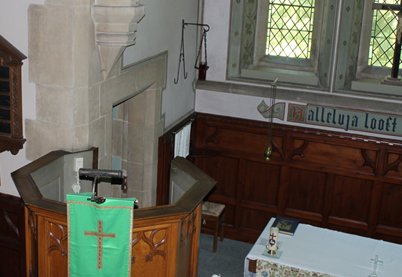
Windows
The Chapel is fitted with tall and narrow leaded glass windows in which lead casings seem to hold together the individual panes. However in some windows the lead casings are fitted on the interior side of the glass pane resulting in a much stronger construction. At the eastern wall there are two equal sized windows, flanking a taller centre window. These windows are, on the outside, reinforced by wrought iron fixtures at regular intervals. Above each window, sand stone pointed arch, decorations are fitted, most probably also intended to prevent rainwater directly dripping onto the window itself. The window frames are decorated with a floral design on the inside.
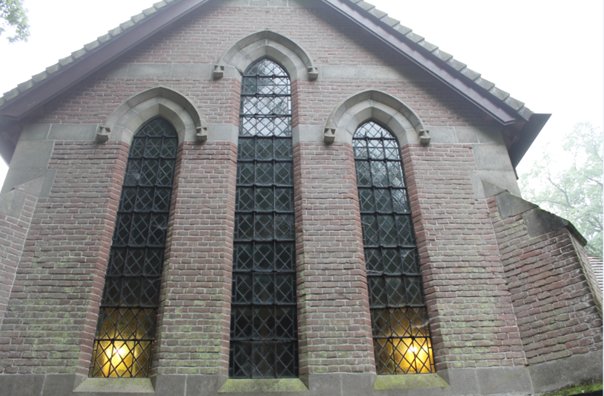
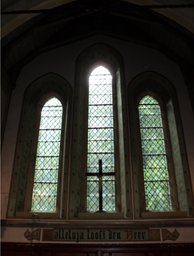
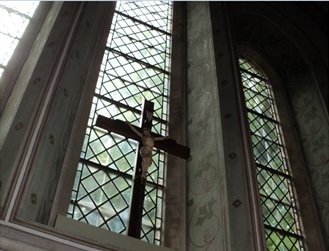
North eastern side – Windows overlooking the liturgical centre
North eastern side – Windows of the liturgical centre. Right image is a single window in the Eastern side, of identical construction.
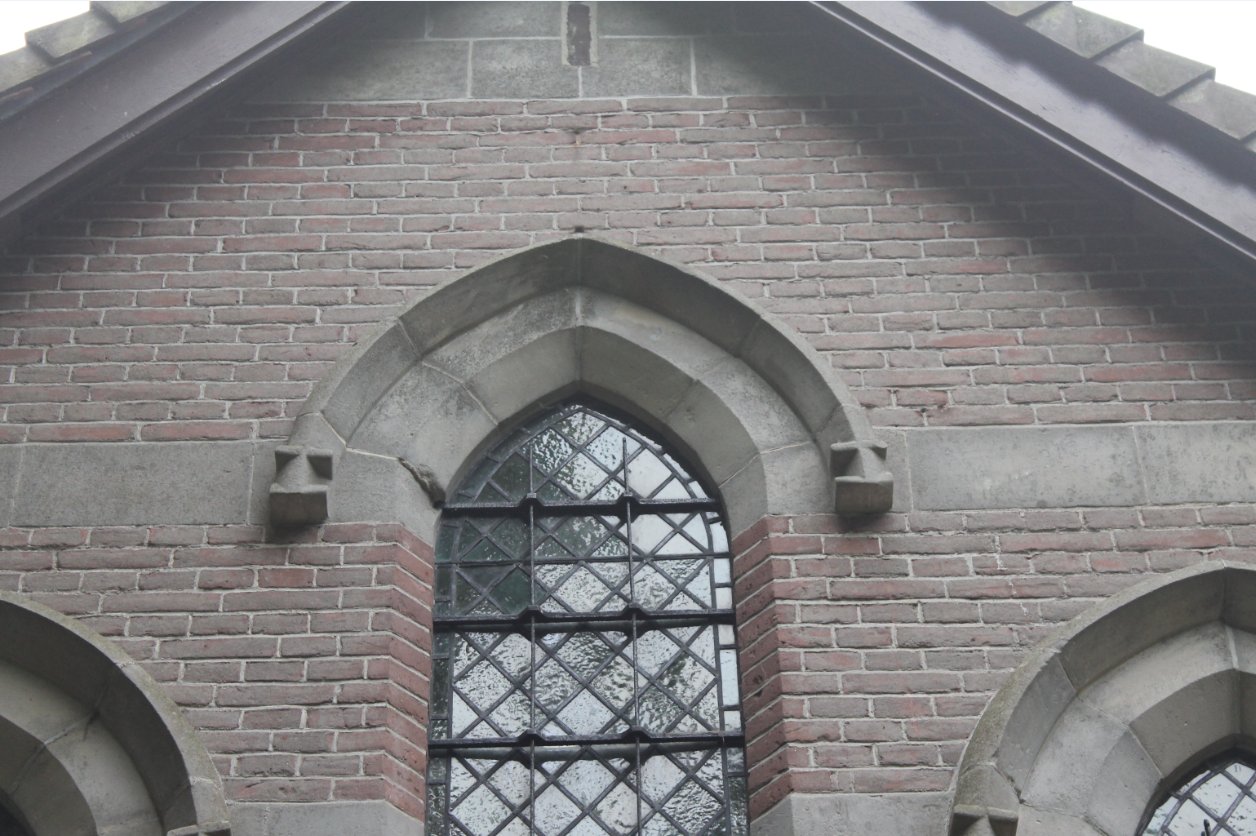

Sand stone pointed arch inset .
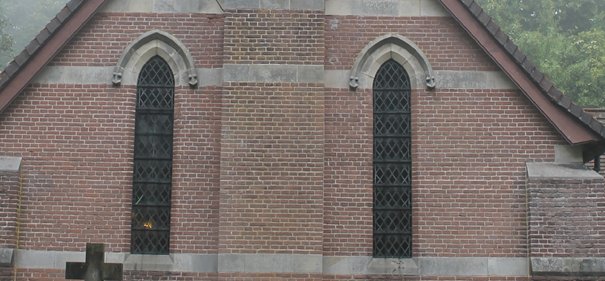
At the South western side two tall windows are set farther apart. This set up was to facilitate an organ gallery intended in between. The inside pointed arch sandstone frames of all tall windows have all been painted with ornamental flowers.
The chapels’ side windows frames are of the ‘abat-jour’ type, noticeable by the sides which have been cut back and whose lower side has been sloped downwards outside and inside, so as to admit a greater amount of light to the interior of the chapel. The side windows are composed of three glass in lead panels with numerous rhombics per section. The individual glass panes are separated inside and out by a sandstone ornamental frame with three modified ogee tops. The outside is reinforced with sideways positioned metal rods with connecting rods halfway and close to the top.
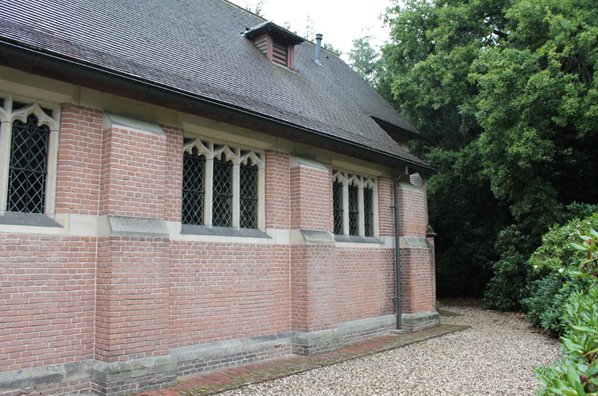

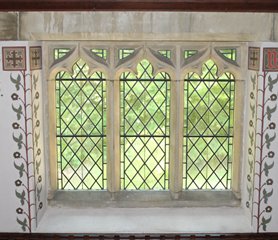
The vestry window is set up as a straight rectangular frame constructed of sand stone uprights and sand stone lintel and window sill. The glass is modelled with lead rhombic, triangular and rectangular shapes. The glass is supported by a metal rods connecting each side and top to bottom.

Roof construction – interior and exterior
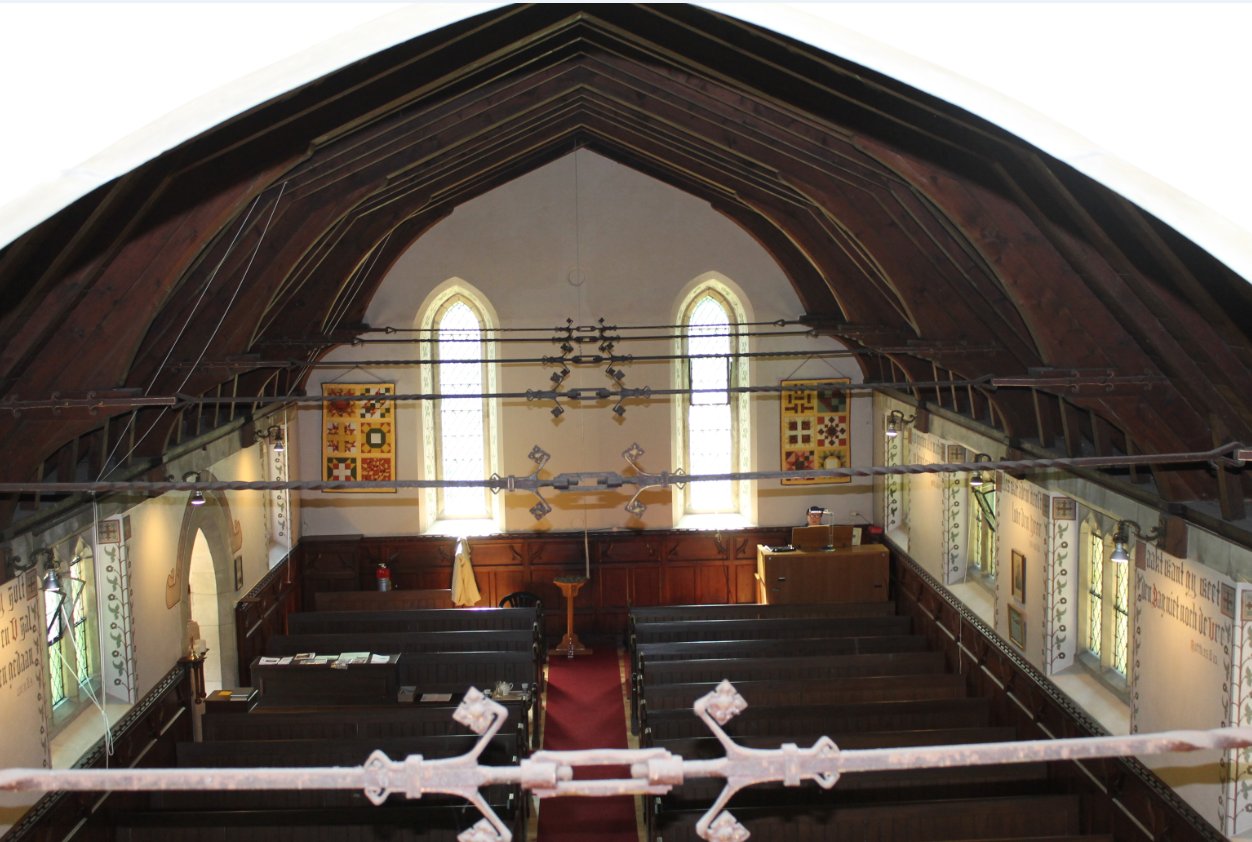
The roof of the Chapel is constructed with the standard rafter beams, connected to a ridge board, supporting the outer panelled wooden skin. The rafter beams are supported by, at approximately half way up, a scissor truss construction. The beams in the truss are thirteen by ten cm strong. This is a type of truss used to support a pitched roof and yet leave the spacious effect intact; the trusses cross each other and are connected to the opposite rafters at an intermediate point along their length. These trusses are set up with a sequential series of one heavy beam scissor, followed by four lighter versions.
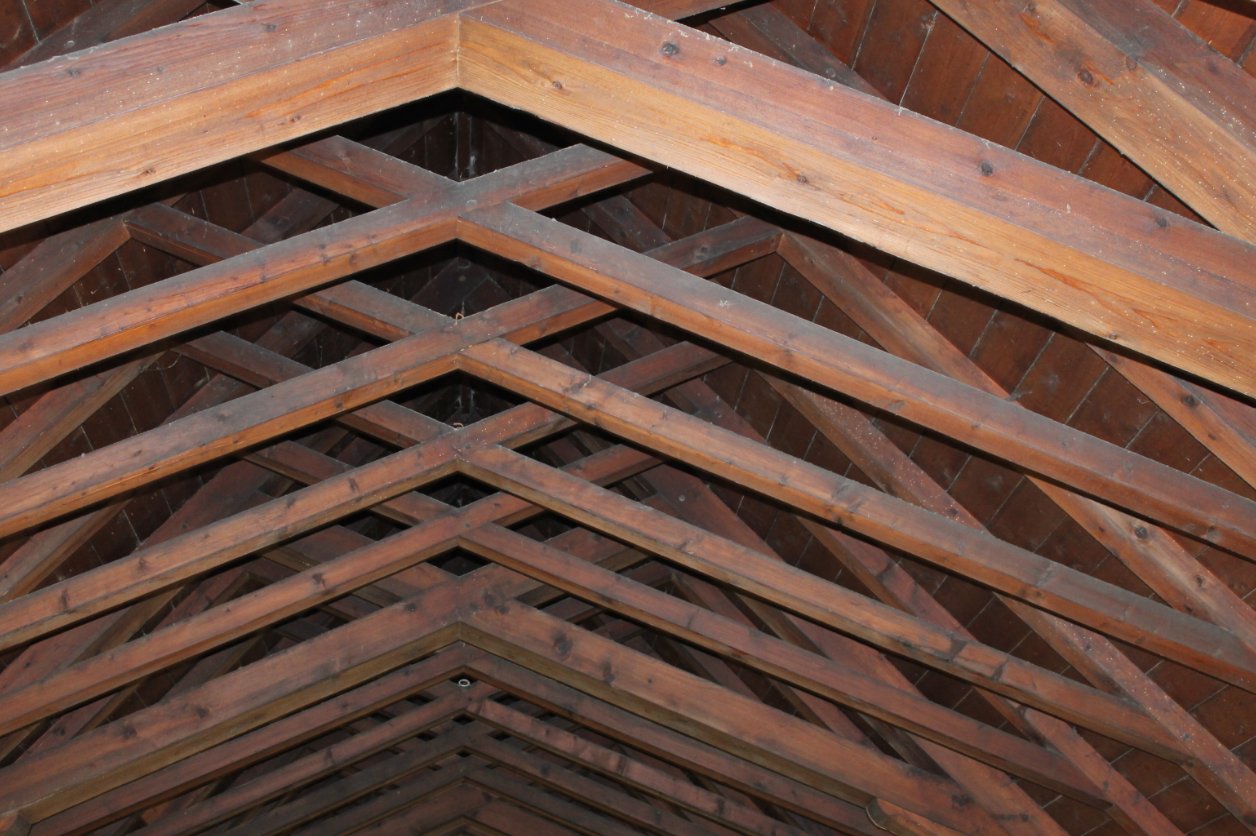
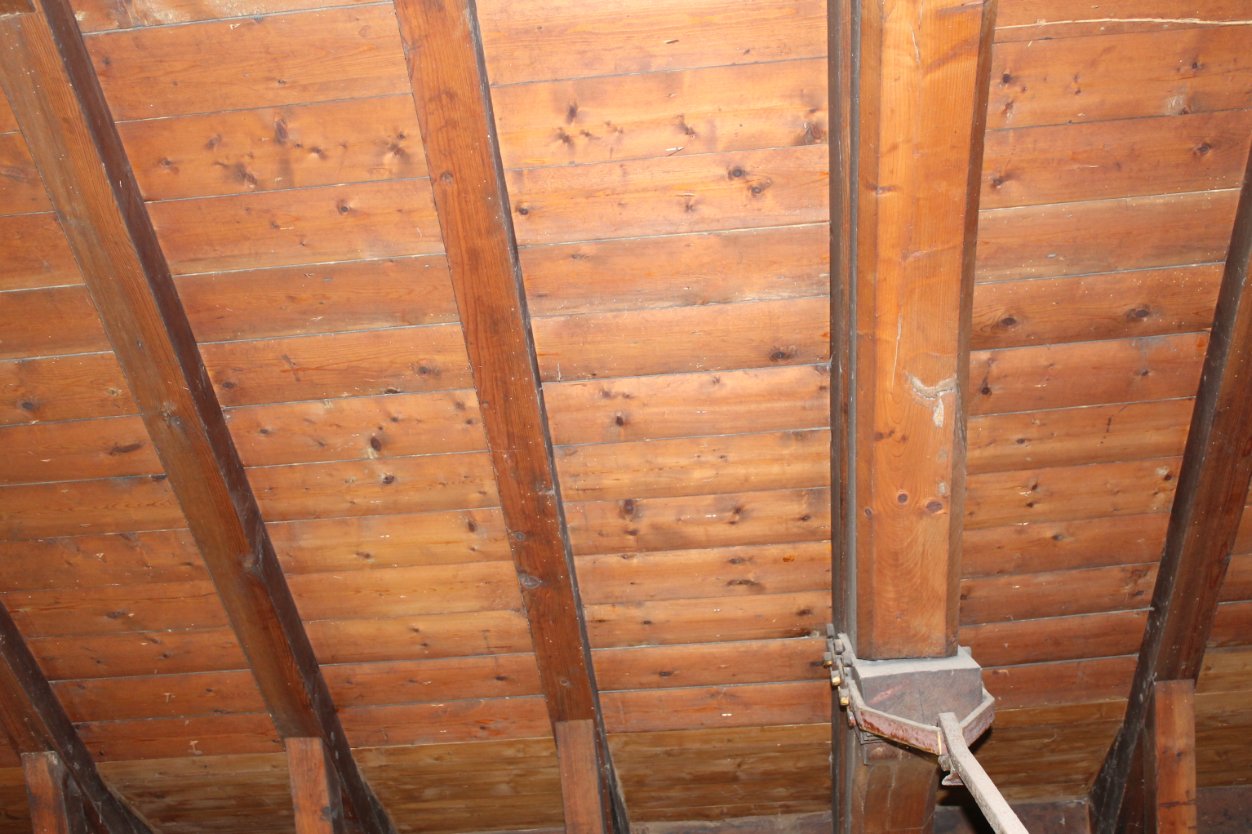
The heavy rafter beams are reinforced on the lower section, resting on a horizontal lintel type wooden beam fitted to the chapel wall and at the top part supporting the scissor truss. These scissor trusses do have an important supporting function for the roof construction.

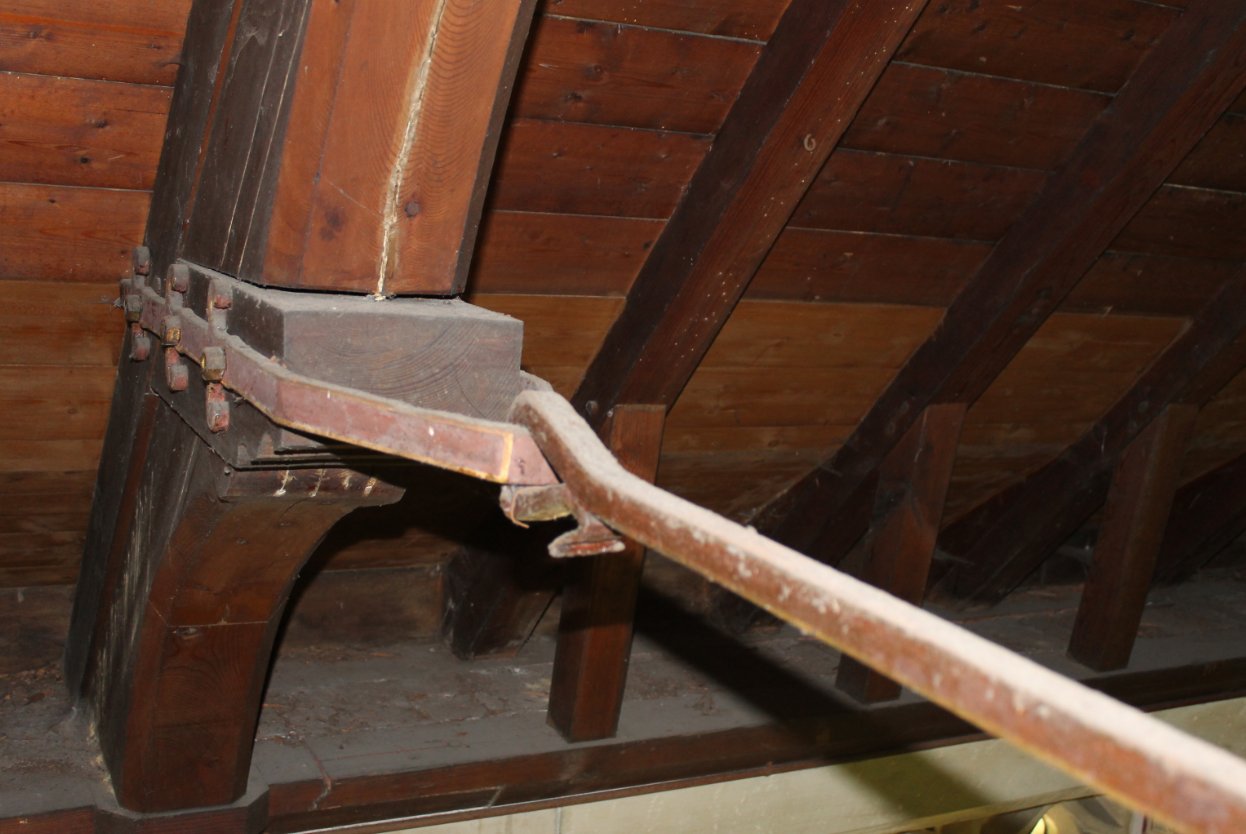
Anchor block with a fork fixture (left image) Wedges insets to accomodate for the lesser roof angle (right image)
The heavy assembly is then connected at approximately a quarter up by means of an wrought iron cross tie assembly. These cross tie sections with three 360 degrees twists centred are connected by a triangle fork with three bolts in a heavy anchor block fixed to the rafter beam assembly.
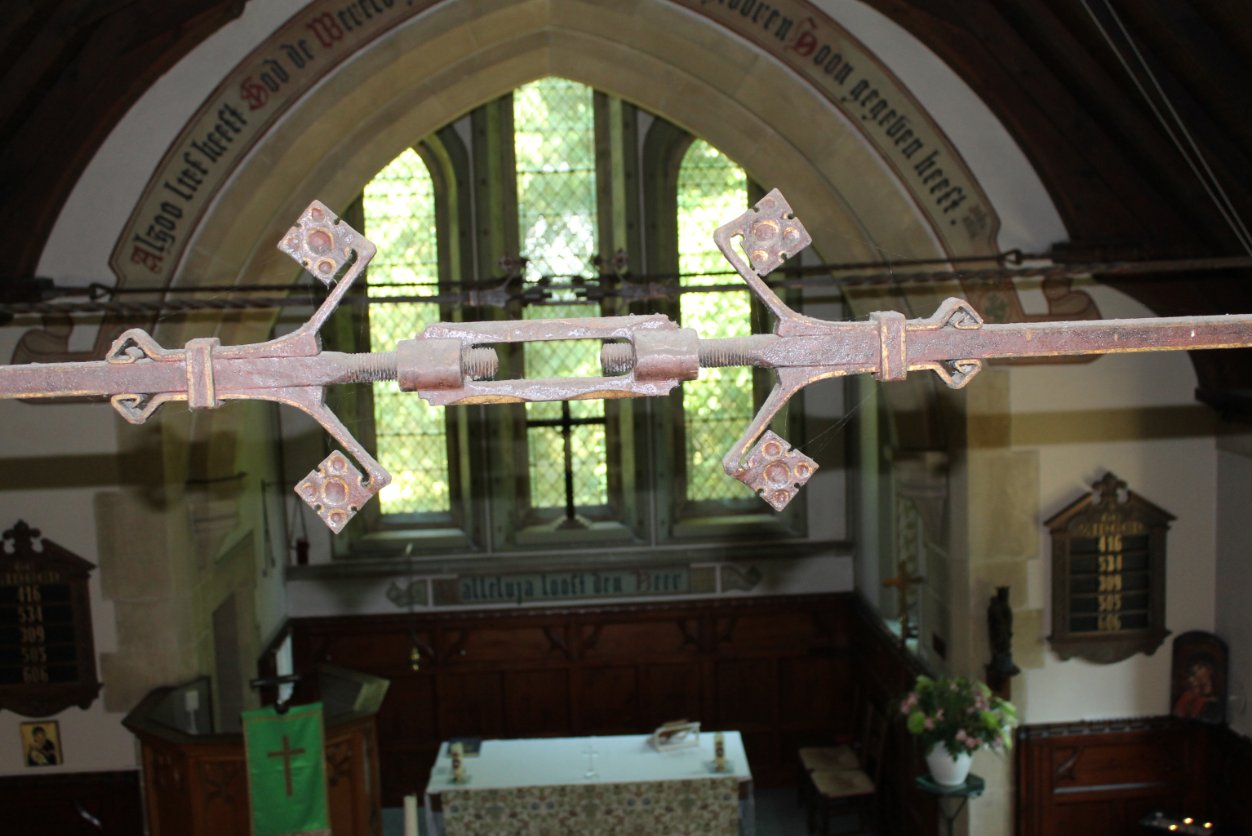
In the centre where the cross ties meet, an ornamented counter rotating spaced nut connects both ends and was therefore adjustable. These cross ties mainly have a supporting function, keeping both bottom parts of the roof sides at the correct location preventing the roof from collapsing. All at the bottom of the rafter beams there is another small wooden support set to create improved stiffness of the roof construction.
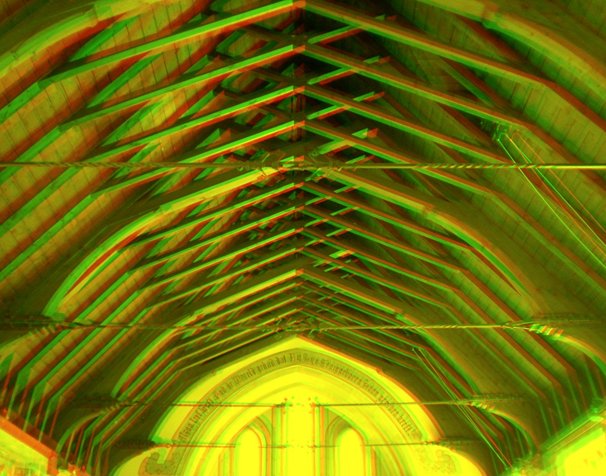
 This anaglyph image may give an in depth impression of the scissor truss roof construction and the location of the iron cross ties.
This anaglyph image may give an in depth impression of the scissor truss roof construction and the location of the iron cross ties. Outside roof cover.

The chapel is fitted with a gable roof which is angled to 45 degrees for the main part, whereas the lower section is set to about 40 degrees. This is mainly to accommodate and to match the thickness of the wall on which the roof is set. The lesser angle on the roof is reached by filling wedges at the lower end of the rafter beams. (see detailed image of beams) The gable roof is covered with roofing tiles of red hard, burnt clay. These tiles, 8mm thick are used on the roof and all top covers of the entire building. The dark weathered red colour matches also the bricks used in the walls and the massive chimney located on the vestry.
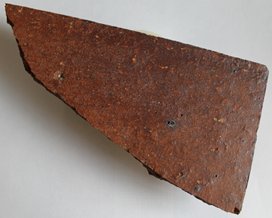
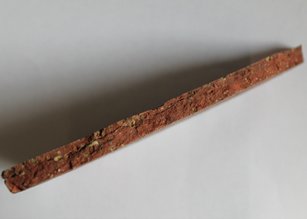
In the 18th century, tiled roofs had become the standard in Europe, wherever there was an abundant local supply of suitable raw materials. Back then, the "craft" of tile making was hard labour and required excellent knowledge of the materials and processes involved. Tile burning was done in piles, in which clay tiles and burning material, like coal or wood, was layered into stacks and covered by earth. The first attempts in industrial production of clay roofing tiles were started in the 19th century. Advances in material knowledge and the introduction of a so called "ring kiln" in 1858 allowed a further advance of the quality. With this kiln, continues burning was achieved. It allowed the gradually rising of the temperature and was fired by coal, thrown in from above. (http://www.clayrooftiles.org/history.htm)
Monitors
In the south eastern roof side, spaced along the main roof structure set at regular intervals, there are three small glassless hipped roof dormers, which are not a part of the roof structure, but are framed separately and may be used for additional ventilation. These dormers are fitted with wooden slatted panels at the exterior. These slatted panels may be operated from the inside with a rope fitted to a lever assembly.
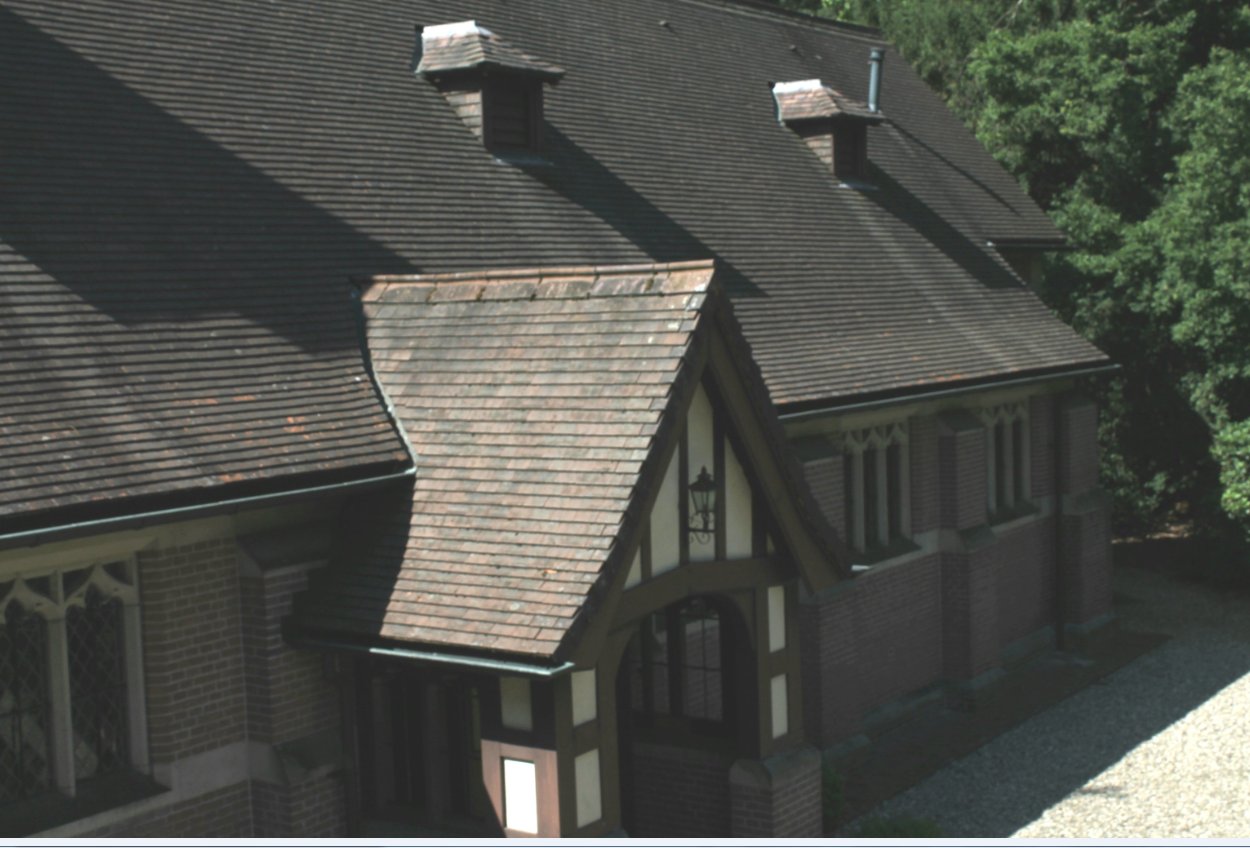

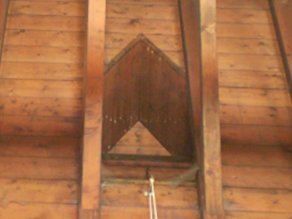
Chimney
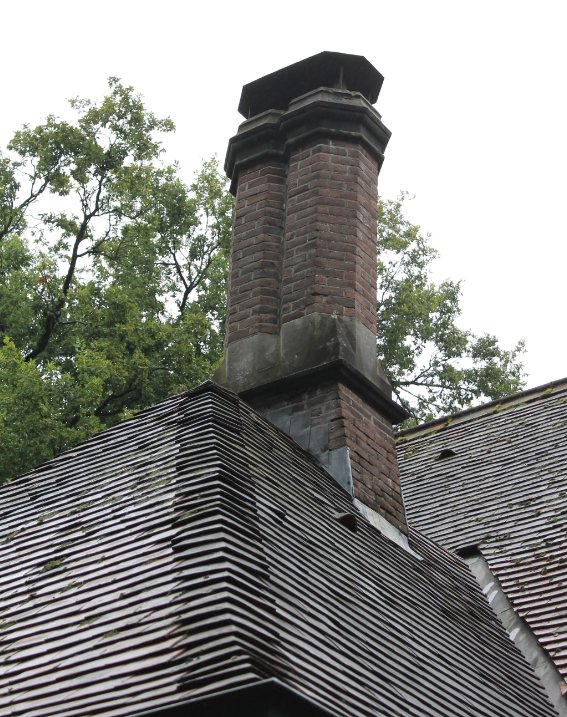
The cottage building style may be easily recognized in the heavy brick chimney assembly which is fitted to the small side extension on the northern side. This chimney consists of two smoke channels. The original heating of the Chapel used to be on this side of the building.
For quite some time, until 2011 heating of the building was through a suspended gas heating system high up next to the south western wall. Exhausting through a hidden chimney in the belfry.
In 2011 this suspended heating system was removed and replaced by a new air heating system again using the original chimney.
Inside painting and artwork
The standard wooden panelling in the roof section and along the lower walls is in a normal darkish tone. However, towards the north eastern end of the Chapel there is another section housing the liturgical centre. This section of approximately three meters in depth does have a different appearance than the plain naturel dark wood panelling of the main Chapel roof. The panels have been painted in light grey and the scissor trusses in an olive finish.

The Hymn Board. The Hymn board was a later addition to the drawings of Wheaterley. The drawing dates back to October 1900, quite some time after the consecration of the building on June 3rd 1900

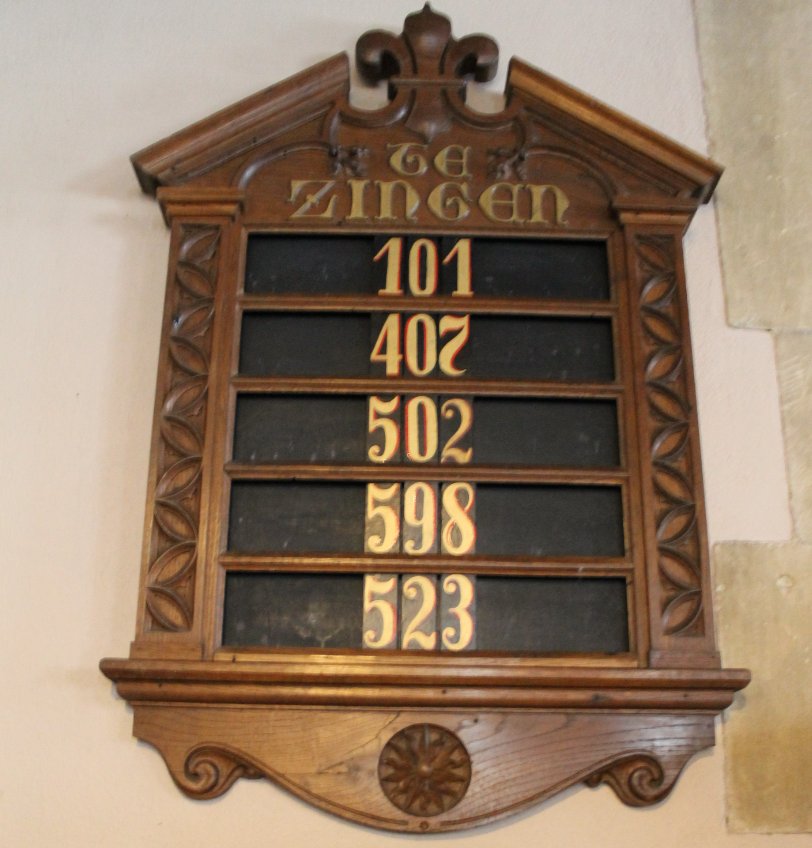
The Pews
The pews have most probably been constructed of local timber from the Weldam Estate. The individual pews seat about six. The front row has been fitted with a skirting resembling the wooden side panelling along the sides of the chapel. Every pew is fitted at the rear with a hymn book support and hooks for kneeling cushions. On the southern side there are nine pews, a gap of two to serve the access, then another three pews. On the northern side there are fourteen pews. At the rear of those the organ is situated.
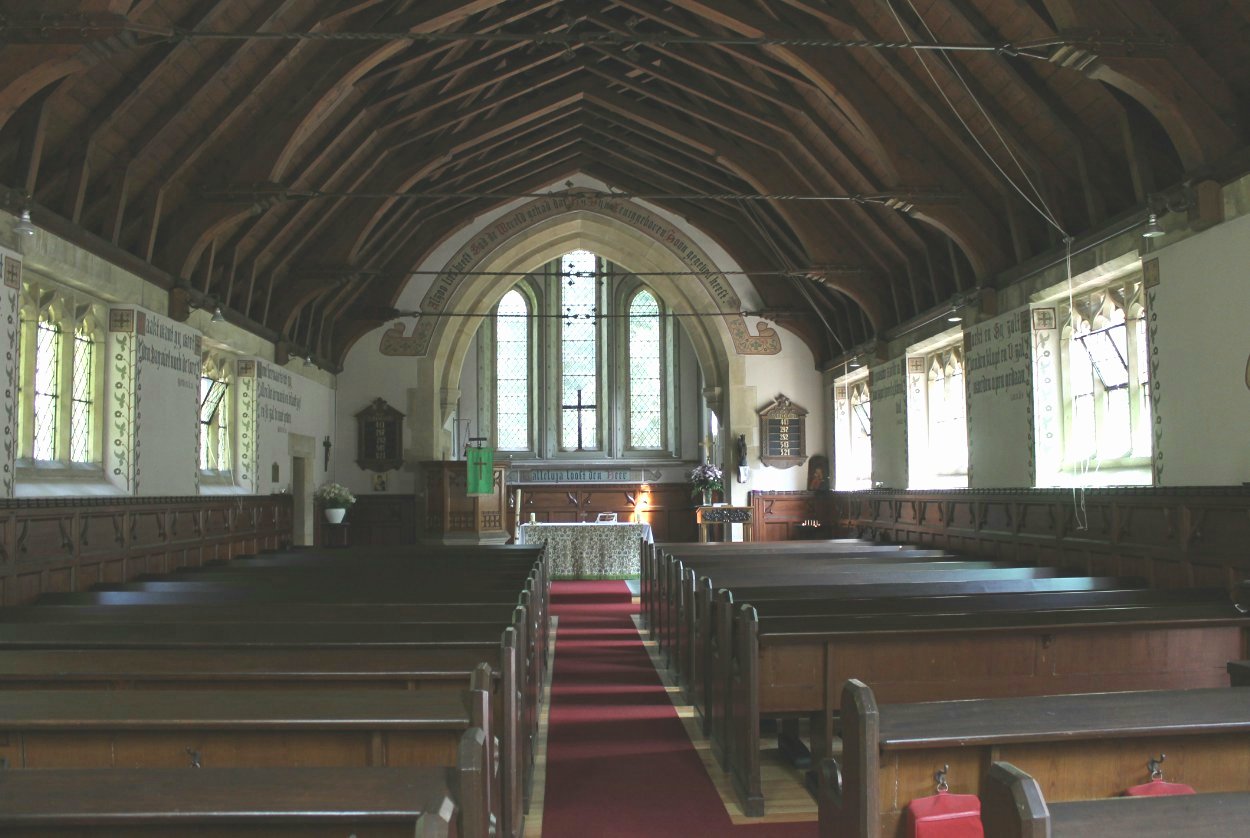
Pews looking towards the liturgical centre.

 (Anaglyph image) Pews looking towards the rear end of the chapel.
(Anaglyph image) Pews looking towards the rear end of the chapel.
Pulpit
The pulpit is located at the section next to the supporting wall separating the main body of the church and the liturgical centre. The elevated open top of the hexagonal shaped pulpit is mounted on a sandstone hexagon pedestal. The pulpit is not fitted with a sound board. The wooden construction is decorated with similar ornaments as seen in the side windows and side wall panelling. The floor of the pulpit is at approximately one meter level.
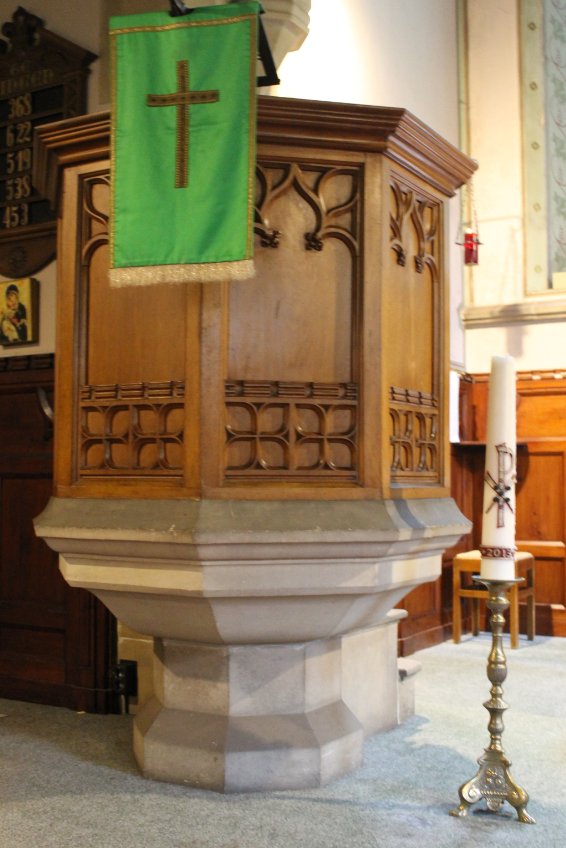

The Organ Gallery
In the archives of Weldam Estate also a drawing exists of an organ gallery. It is not clear if the organ gallery has been implemented in the chapel at the building phase. If it has been there the organ gallery has been removed quite some time ago. When discussing this organ gallery with Count Alfred zu Solms Sonnenwalde, he mentioned that it was not present as long as he could remember, at least not after when he came to live at the Weldam Estate in the fifties. He could remember a harmonium being present in the chapel. At the moment a small size electronic organ is installed at the rear left quarter of the chapel. As mentioned before, because of the (planned) organ gallery, only two windows have been set in the South western wall of the chapel.
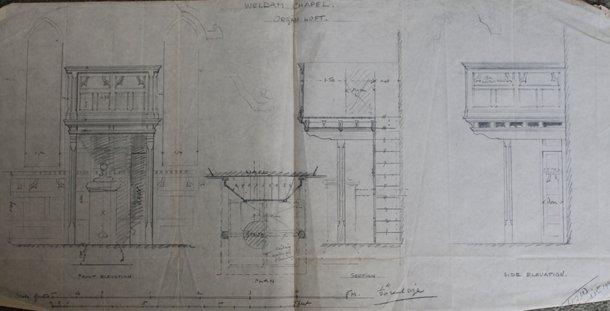
The Belfry
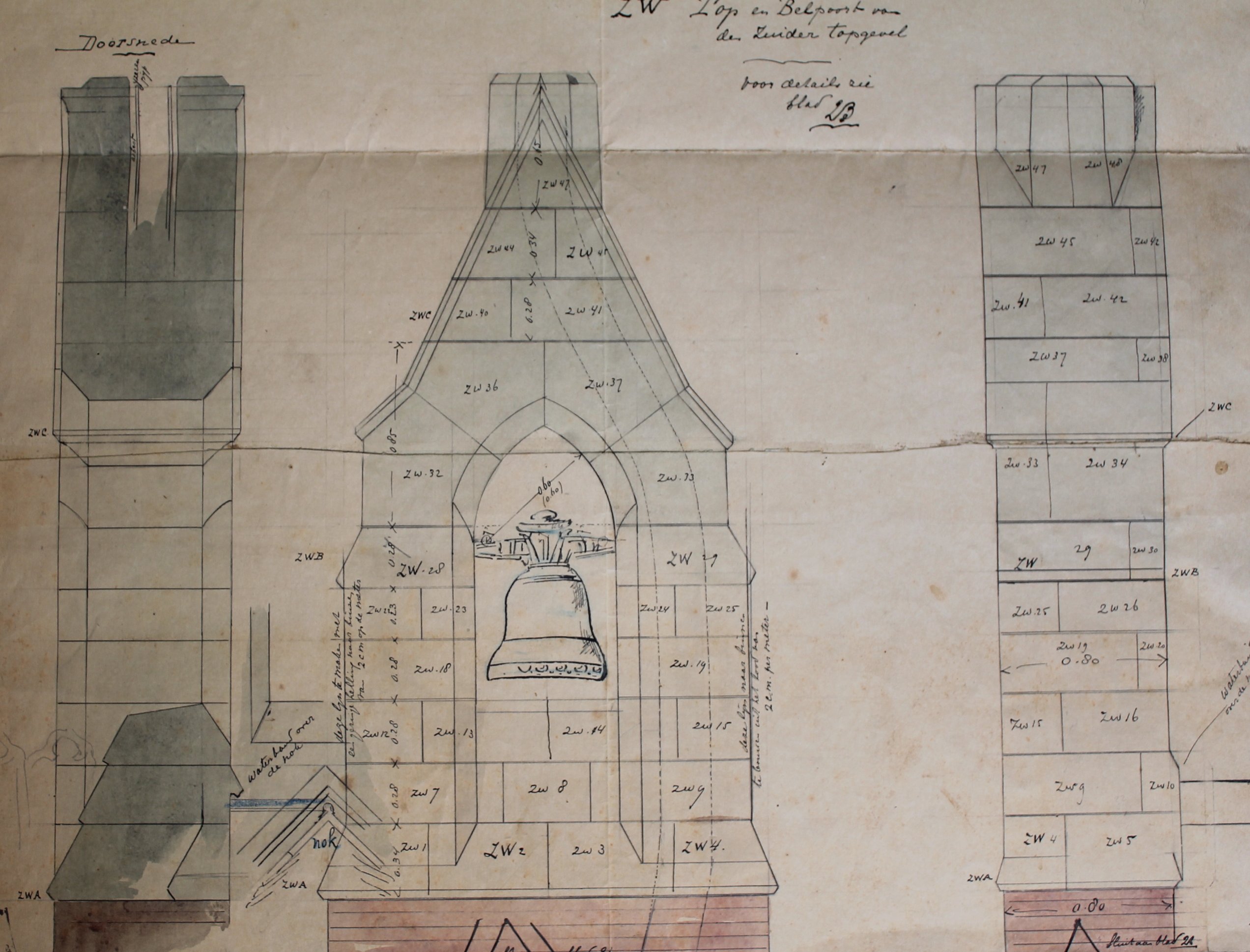


In the South western wall a belfry built up of sand stone blocks has been built. There is only a single bell fitted in the belfry, attached to a semi-circular bell wheel which is connected with a bell rope in the rear of the chapel. The approximatre size of the bell is 56 centimetres at its maximum width.
Incorporated in this belfry there is also a hidden chimney. (see right image)This chimney was used when the chapel was heated with an air heating system which was suspended from the roof at the rear end. When the new underfloor air heating system was installed at a major renovation project involving a new floor this chimney was closed up.

Bell in motion during the call to Worship on a Sunday mornings.